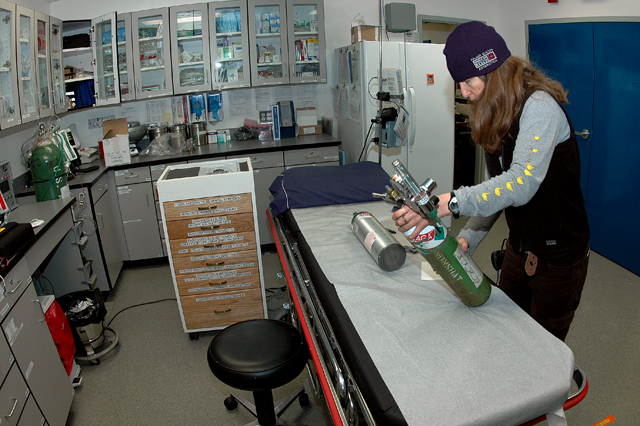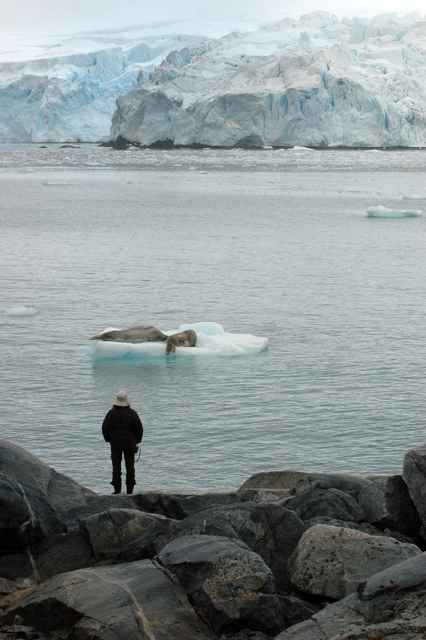Diving into medicineNomadic Palmer doctor takes her skills around the worldPosted April 9, 2010
Dr. Joanne Feldman had no intentions of following her father into medicine. The job seemed to be nothing but grind, as she watched her father working all hours, taking calls at all hours. “That’s all I saw. I never saw the amazing part of it,” says Feldman, the sole physician at the U.S. Antarctic Program’s Palmer Station An outdoor enthusiast, Feldman instead went to school and got a master’s degree in environmental education to fulfill a lifelong dream of becoming a ranger for the National Park Service It was during her work with the park service that she got interested in wilderness emergency medicine. Eventually, she gained the skills and training as a paramedic, with the idea of working for the park service as a medic. “Then I just decided to become a doctor specializing in wilderness and emergency medicine,” Feldman says. That was about 11 years ago, and the 47-year-old emergency physician turned that career choice into a ticket to see the world, from Mount Everest to Antarctica. Feldman looks the role of a doctor of a deep field camp. A trim, fit woman, she wears her Palmer Station ski cap pulled down low on thick auburn hair. She usually sports rubber sandals on the relatively mild summer days at the research station, located just north of the Antarctic Circle off the Antarctic Peninsula. She goes by “DoJo” at Palmer, where people seem to adopt nicknames more readily than a pro baseball team. This is her first season at Palmer, though for the last three years she worked as a ship doctor aboard Antarctic tourist ships a few weeks each austral summer. “When I was down last time I realized I wasn’t getting enough time down here. I jut want to live down here longer. That’s why I applied.” She got her wish with a seven-month contract to head the station’s small clinic, a modern facility with telemedicine capability that allows her to consult with doctors in the United States through a video link. “I have a lot of equipment here,” she notes. “What I don’t have is the ease of getting someone rescued if I need to — and that’s when it becomes wilderness medicine.” Fortunately, Feldman spends little time being a doctor. Most of the work involves attending to administrative duties, weeding out obsolete equipment in the clinic, and leading the station’s trauma team. She also plans and runs the monthly fire drills. Back in the States, Feldman works as an emergency physician at several hospitals in California, where she also specializes in hyperbaric dive medicine. But she also jumps off onto other trips whenever possible. In June 2009, she did a month-long trip from Chile to Long Beach on the TS Golden Bear, the training ship of the California Maritime Academy Another unusual doctoring stint sent her 60-feet underwater on a visit to Aquarius “I’m not permanent anywhere, so that’s why I’m able to do this,” she says. “I’ll just disappear and have little adventures here and there.” A month-long research gig looking at the incidence of blood clots in high-altitude climbers at Mount Everest Base Camp helped persuade her of two things: She wasn’t interested in research. And she never wanted to be far from the water. “It dawned on me: Why am I going up to the Himalaya? Why am I doing this or that? I live on the ocean. I surf on the ocean. I love the ocean. Why don’t I just focus on ocean stuff?” she explains. “I’m pretty much all ocean-based these days. I don’t want to be high-altitude. I don’t want to be anywhere else. I just want to be on the ocean.” That’s an easy request to fill at Palmer Station, a small research base clinging to the rocky edge of Anvers Island. The region is home to Adélie, chinstrap and gentoo penguins, which spend the summer on the nearby islands raising their chicks. Elephant seals, fur seals, leopard seals and crabeater seals are also common in the summer, along with hungry humpback whales feeding on krill swarms. It’s the scenery at these remote locations that draws Feldman — and will probably continue to send her around the world. “I’ve definitely been the nomad ... There are just too many places to experience.”
|



For USAP Participants |
For The Public |
For Researchers and EducatorsContact UsU.S. National Science FoundationOffice of Polar Programs Geosciences Directorate 2415 Eisenhower Avenue, Suite W7100 Alexandria, VA 22314 Sign up for the NSF Office of Polar Programs newsletter and events. Feedback Form |



